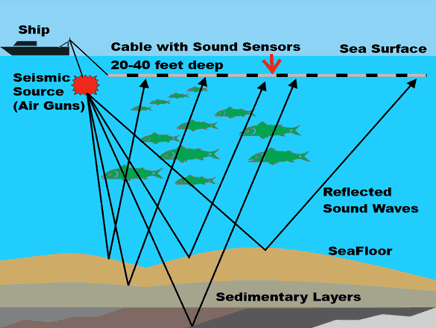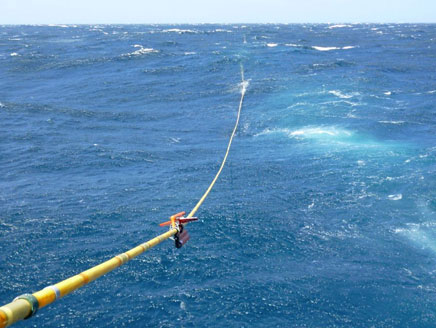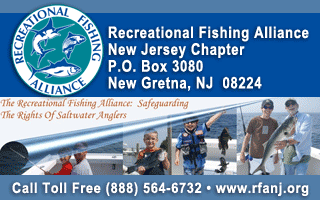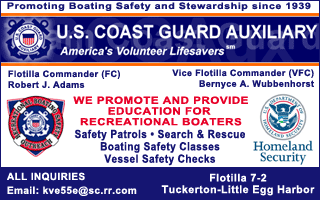
The study was proposed to better understand climate change and historical changes in sea level... However, the data gathered will be public information and there is no doubt that the oil and gas industry could use the data to look for gas deposits...
By Tom Vassallo
As if New Jersey's fishing industry hasn't endured enough already this year, a seismic study proposed for an area as close as 15 miles from Barnegat Bay would blast the ocean floor with seismic air cannons at incredible sound levels exceeding the level of a Saturn rocket launch. According to a "NJ Fact Sheet" prepared by Clean Ocean Action, the study would take place just 15 miles off the Barnegat Inlet, in a 230 square mile area, and would blast sound waves that are louder than a jet plane at takeoff every 5-10 seconds...continuously...24 hours each day for 30 days from June through July. The study could also extend into August if there are any disruptions. These astonishingly loud blasts will be emitted from up to 8 seismic air guns firing at once.
Seismic surveys have already been used off the ocean coasts by the offshore oil and gas industry to help determine the location of oil and gas deposits beneath the seafloor. These surveys utilize large, specialized ships which tow an array of powerful air guns that generate sound waves by firing off explosive blasts of air. The sound waves are reflected off the seafloor and create a picture of underwater geological formations. This particular seismic study, just 15 miles from the Barnegat inlet, has been proposed by researchers from three universities including Columbia University's Lamont-Doherty Earth Observatory, the University of Texas, Rutgers University and is reported to include researchers from the National Science Foundation as well.
 |
| Ships drag air cannons which fire compressed air at up to 250 dB to the ocean floor. The reflected sound energy is read by sensors dragged on a cable on the ocean surface. the data is read by software and translated into images. (FishinJersey Graphic) |
According to a fact sheet published by Clean Ocean Action (www.cleanoceanaction.org), the "purpose of the study is to assess deep sea sediments from 60 million years ago to better understand climate change and historical changes in sea level. However, the data gathered will be public information and there is no doubt that the oil and gas industry could use the data to look for gas deposits—especially methane hydrates, frozen natural gas, also known as fire ice. These can be found well within the 11,500 foot depth range of the study."
It is important to understand that sound isn't just "noise", sound is energy. That energy at high levels can not only damage hearing but actually cause fatal injury. Oh...we are not talking fish right now...we are talking about sound energy with the ability to kill humans. In a Cornell University Peace Studies Program analysis authored by German scientist Jurgen Altmann, he writes, "Shock waves from explosive blasts—for which the name 'acoustic' is questionable—can have various effects. At moderately high levels (up to about 140 dB), there is temporary hearing loss, which can turn into permanent [loss] at higher values. Above 185 dB eardrums begin to rupture. At even higher levels (about 200 dB, overpressure already 3 times the atmospheric pressure), lungs begin to rupture, and above about 210 dB some deaths will occur." Pretty scary stuff...especially since (according to the Alaska Marine Council):"The intensity of sound waves produced by the firing of seismic air guns can reach up to 250 decibels (dB) near the source and can be as high as 117 dB over 20 miles away." That means that 20 miles away, 117 dB levels will still be reached. That is above the human pain threshold and those levels can result in hearing loss after 8 continuous hours.
What is much more troubling for New Jersey's commercial fishing fleet is that in the past, these seismic studies have taken place off the Alaskan coast and their effects on the commercial cod, haddock and rockfish industries are clearly documented in their fact sheet entitled "Impacts of Seismic Surveys on Marine Mammals and Fish" by the Alaska Marine Conservation Council.
According to the Alaskan study, "Seismic surveys not only threaten commercial and subsistence fishing by harming fish resources, but also by interfering with fishing operations and dramatically affecting catch rates. Seismic ships tow streamers that can be miles long. These can get tangled up with crab pots, set nets and trawl nets causing damage and decreasing crucial fishing time. As a result, seismic survey operations can end up competing with fishing for time and space on the water."
The Alaskan Marine Council study goes on to state that: "Even if these kinds of conflicts can be avoided, several studies have shown that seismic operations have greatly reduced catches of fish around areas where air guns were being fired. These studies have demonstrated reduced catches over 20 miles away from the source with catch reductions continuing five days after the testing was complete (See Table below). Researchers believe these catch reductions are a result of altered fish behavior due to seismic operations which cause them to be less likely to take hooks and/or to move down and away from the seismic firing."
Reductions in Alaskan Fish Catch Rates as a result of seismic survey activity
Species |
Gear type |
Noise level of |
Catch reduction |
Source |
Atlantic cod |
Trawl |
250 decibels (dB) |
46-69% lasting at least |
Engas et al. 1993 |
Atlantic cod |
Longline |
250 decibels (dB) |
17-45% lasting at least |
Engas et al. 1993 |
Atlantic cod |
Longline |
Undetermined, 9.32 |
55-79 % lasting at least |
Lokkeborg and Soldal, 1993 |
Haddock |
Trawl |
250 decibels (dB) |
70-72% lasting at least |
Engas et al. 1993 |
Haddock |
Longline |
250 decibels (dB) |
49-73% lasting at least |
Engas et al. 1993 |
Rockfish |
Longline |
223 decibels (dB) |
52%- effect period not |
Skalski et al., 1992 |
(Source of Chart: Alaskan Marine Council)
According to Clean Ocean Action, "A 2003 study in the Journal of the Acoustical Society of America confirmed that seismic air guns used in underwater oil exploration damage the auditory organs of fish. More studies are finding impacts of seismic testing and other acoustic technology range from harassment to death. The Environmental Assessment prepared for this study scarcely considers the serious threats to fish and shellfish. It devotes less than 250 words to marine invertebrates (crustaceans and cephalopods), fish and their fisheries, and it does not mention impacts to bivalves such as surf clams and scallops." It seems that the institutions proposing this study really haven't much concern about the effects it may have on New Jersey crabs, squid, shrimp, clams and scallops either.
However, that is not the only marine population that can be effected. Scientists believe that pods of whales that include calves are at serious risk from seismic activities due to their need to utilize critical habitats for feeding and resting. If seismic surveys displace whales from these areas so critical to their survival, population-level consequences may result. Dr. Lance Barret-Lennard, Senior Marine Mammal Scientist at the Vancouver Marine Science Center, has asserted that seismic exploration is one of the two greatest threats to whales and dolphins. |
| Seismic ships tow LONG cables which may interfere with commercial longliners and trawlers. Studies in Alaska confirmed reductions in commercial catches. The study also reported changes in fish patterns and whale migratory pattern changes. |
FishinJersey.com feels that the seismic testing will pose a serious danger to marine mammals and possibly impact commercial fishing catch rates for trawlers and longliners at a critical period during the fishing season. There are also unanswered questions about its impact upon marine invertebrates and shellfish. Blasts from these seismic air guns are so loud and constant that they can injure or disturb vital behaviors in fish, dolphins, whales and sea turtles. The marine life impacts from these blasts can include temporary and permanent hearing loss, abandonment of habitat, disruption of mating and feeding, and beach strandings...even death. The use of seismic air guns for research or oil and gas exploration will threaten endangered species, fisheries and coastal economies throughout the Atlantic. With concerns about the stability of our striped bass and fluke population in this region, it would seem foolish to approve any seismic testing so close to this important fishery. We are hopeful that the "powers that be" recognize the detrimental effect it could have on our extremely sensitive marine environment. It is a calculated risk that certainly cannot be worth the price of our fish, turtles and marine mammals' health and well being...nor can our commercial fishing fleet handle another damaging blow to the industry.
Paul Haertel, President of the Jersey Coast Anglers Association attended a meeting of the New Jersey Marine Fisheries Council (NJMFC) on May 1st. At the meeting, the NJMFC voted to write letters opposing seismic blasting off of Barnegat Inlet. In addition, he reports that they also voted to write letters opposing sand being taken from lumps such as Manasquan Inlet to use for beach replenishment projects. It is becoming evident that New Jersey seems to be more interested in the ease of obtaining raw materials for beach replenishment than protecting our marine environment. We agree that the beachfront replenishment protects safeguard our beachfront homes and commercial properties. They are valuable to our tourism and economy. However, the state needs to work along with our recreational and commercial fishing industries and consider them in ANY decision that will impact their respective industries. Protecting the irreplaceable marine life which inhabits our ocean and contributes millions of dollars to the state's economy and tourism, should also be a considerable concern. The time has come to involve New Jersey anglers in these decisions and to consult representatives of our fishing industries in ANY study or project involving our ocean, bays and estuaries.















